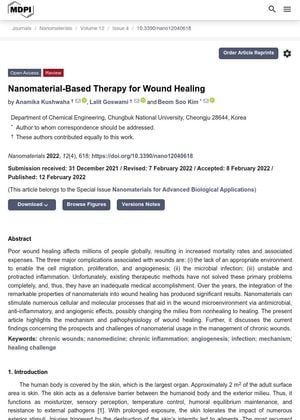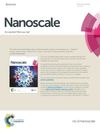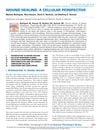Nanomaterial-Based Therapy for Wound Healing
February 2022
in “
Nanomaterials
”
nanomaterials zinc oxide gold nanoparticles silver nanoparticles copper nanoparticles peptide nanoparticles synthetic polymeric nanostructures polymeric compositions gelatin-based scaffolds fibrin hydrogels liposomes lipid nanoparticles antimicrobial anti-inflammatory angiogenic cell migration cell proliferation angiogenesis microbial infection inflammation toxicity biomolecules wound healing nanoparticles gold silver copper peptides polymers gelatin lipids cell growth infection

TLDR Nanomaterials show promise in improving wound healing but require more research on their potential toxicity.
The review "Nanomaterial-Based Therapy for Wound Healing" discusses the potential of nanomaterials in improving wound healing, a problem affecting millions worldwide. Current therapies have not fully addressed the main complications of wound healing, including lack of a suitable environment for cell migration, proliferation, and angiogenesis; microbial infection; and unstable, prolonged inflammation. Nanomaterials, including metal nanoparticles like zinc oxide, gold, silver, and copper, as well as peptide nanoparticles and synthetic polymeric nanostructures, have shown promise in stimulating cellular and molecular processes that aid wound healing. They have antimicrobial, anti-inflammatory, and angiogenic effects. Polymeric compositions, gelatin-based scaffolds, fibrin, hydrogels, liposomes, and lipid nanoparticles have also been used to promote cellular proliferation and tissue repair. However, potential toxicity of nanoparticles necessitates further research. The document also discusses the role of various biomolecules in wound healing. Despite challenges like reproducibility, stability, toxicity, and histocompatibility, the application of nanomaterials for wound treatment is rapidly increasing.


